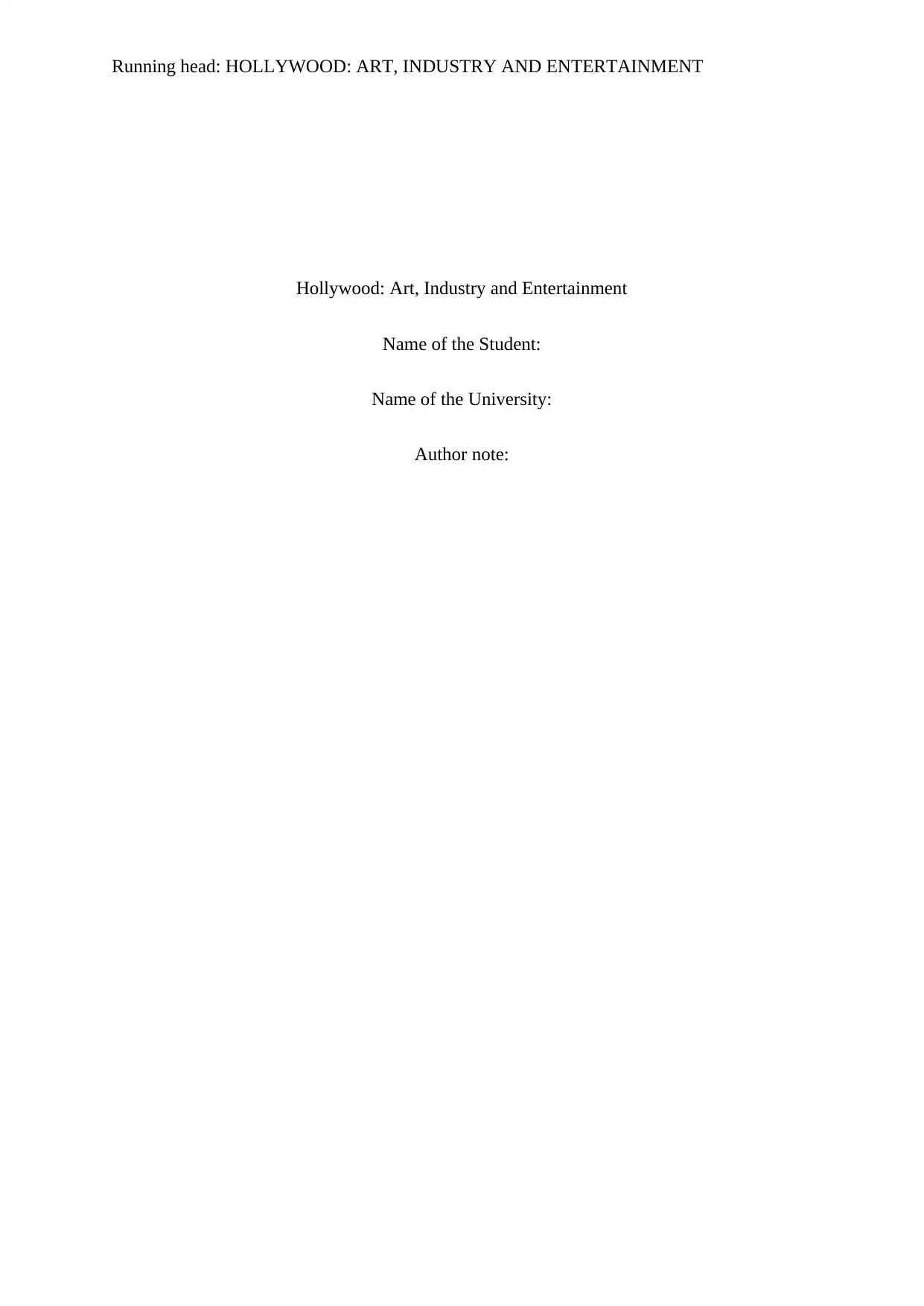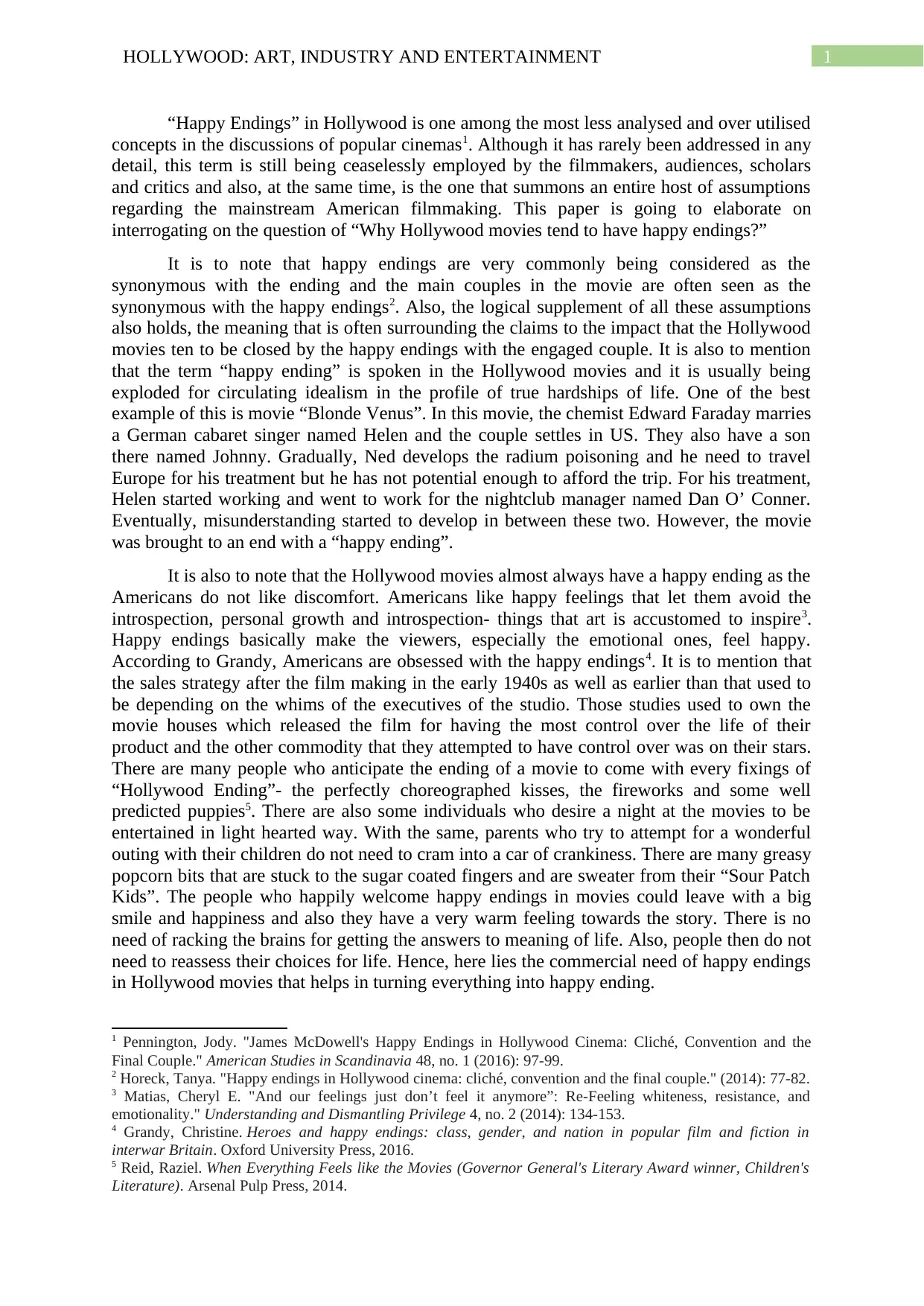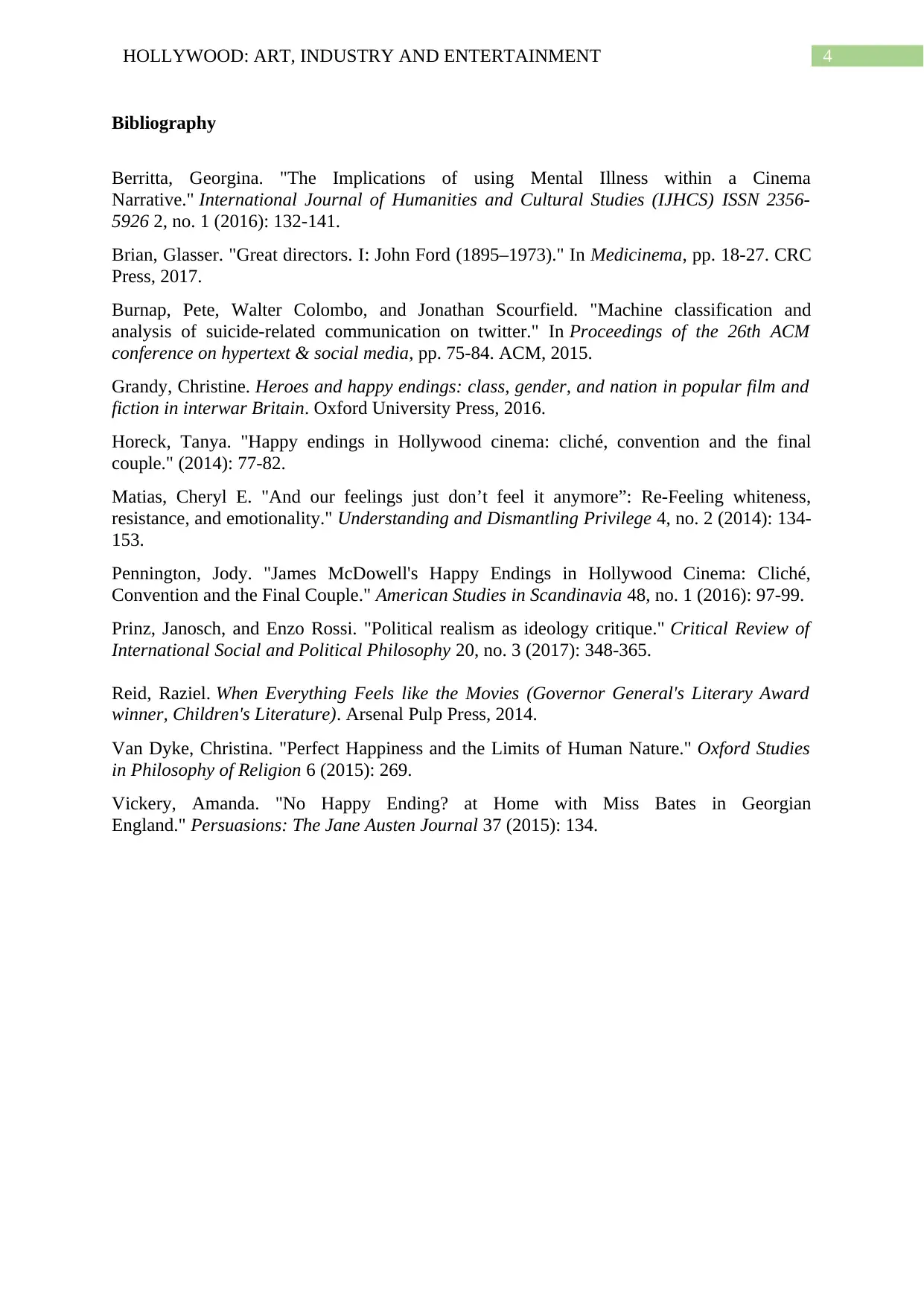Hollywood's Happy Endings: Art, Industry, and Entertainment Analysis
VerifiedAdded on 2021/11/10
|5
|1804
|211
Essay
AI Summary
This essay delves into the pervasive use of happy endings in Hollywood cinema, questioning the reasons behind their prevalence. It examines the historical and commercial influences, such as studio control and audience preferences, that have shaped this trend. The essay explores the concept of happy endings as synonymous with the conclusion of a film and the resolution of the main couple's journey. It analyzes the function of happy endings in circulating idealism and providing escapism, contrasting them with the complexities of real life. Moreover, it discusses the cultural impact of happy endings and the role of art, introspection, and personal growth. The essay highlights the commercial needs that drive these endings, as well as the potential ideological implications and complacency they might promote. Through examples like "Blonde Venus" and "Stagecoach", the essay explores how happy endings can be a tool to uplift viewers and provide entertainment, while also acknowledging the importance of occasionally incorporating sad endings to maintain suspense and challenge audience expectations. The essay concludes by suggesting that while happy endings offer escapism, they shouldn't be the only approach in movies.

Running head: HOLLYWOOD: ART, INDUSTRY AND ENTERTAINMENT
Hollywood: Art, Industry and Entertainment
Name of the Student:
Name of the University:
Author note:
Hollywood: Art, Industry and Entertainment
Name of the Student:
Name of the University:
Author note:
Paraphrase This Document
Need a fresh take? Get an instant paraphrase of this document with our AI Paraphraser

1HOLLYWOOD: ART, INDUSTRY AND ENTERTAINMENT
“Happy Endings” in Hollywood is one among the most less analysed and over utilised
concepts in the discussions of popular cinemas1. Although it has rarely been addressed in any
detail, this term is still being ceaselessly employed by the filmmakers, audiences, scholars
and critics and also, at the same time, is the one that summons an entire host of assumptions
regarding the mainstream American filmmaking. This paper is going to elaborate on
interrogating on the question of “Why Hollywood movies tend to have happy endings?”
It is to note that happy endings are very commonly being considered as the
synonymous with the ending and the main couples in the movie are often seen as the
synonymous with the happy endings2. Also, the logical supplement of all these assumptions
also holds, the meaning that is often surrounding the claims to the impact that the Hollywood
movies ten to be closed by the happy endings with the engaged couple. It is also to mention
that the term “happy ending” is spoken in the Hollywood movies and it is usually being
exploded for circulating idealism in the profile of true hardships of life. One of the best
example of this is movie “Blonde Venus”. In this movie, the chemist Edward Faraday marries
a German cabaret singer named Helen and the couple settles in US. They also have a son
there named Johnny. Gradually, Ned develops the radium poisoning and he need to travel
Europe for his treatment but he has not potential enough to afford the trip. For his treatment,
Helen started working and went to work for the nightclub manager named Dan O’ Conner.
Eventually, misunderstanding started to develop in between these two. However, the movie
was brought to an end with a “happy ending”.
It is also to note that the Hollywood movies almost always have a happy ending as the
Americans do not like discomfort. Americans like happy feelings that let them avoid the
introspection, personal growth and introspection- things that art is accustomed to inspire3.
Happy endings basically make the viewers, especially the emotional ones, feel happy.
According to Grandy, Americans are obsessed with the happy endings4. It is to mention that
the sales strategy after the film making in the early 1940s as well as earlier than that used to
be depending on the whims of the executives of the studio. Those studies used to own the
movie houses which released the film for having the most control over the life of their
product and the other commodity that they attempted to have control over was on their stars.
There are many people who anticipate the ending of a movie to come with every fixings of
“Hollywood Ending”- the perfectly choreographed kisses, the fireworks and some well
predicted puppies5. There are also some individuals who desire a night at the movies to be
entertained in light hearted way. With the same, parents who try to attempt for a wonderful
outing with their children do not need to cram into a car of crankiness. There are many greasy
popcorn bits that are stuck to the sugar coated fingers and are sweater from their “Sour Patch
Kids”. The people who happily welcome happy endings in movies could leave with a big
smile and happiness and also they have a very warm feeling towards the story. There is no
need of racking the brains for getting the answers to meaning of life. Also, people then do not
need to reassess their choices for life. Hence, here lies the commercial need of happy endings
in Hollywood movies that helps in turning everything into happy ending.
1 Pennington, Jody. "James McDowell's Happy Endings in Hollywood Cinema: Cliché, Convention and the
Final Couple." American Studies in Scandinavia 48, no. 1 (2016): 97-99.
2 Horeck, Tanya. "Happy endings in Hollywood cinema: cliché, convention and the final couple." (2014): 77-82.
3 Matias, Cheryl E. "And our feelings just don’t feel it anymore”: Re-Feeling whiteness, resistance, and
emotionality." Understanding and Dismantling Privilege 4, no. 2 (2014): 134-153.
4 Grandy, Christine. Heroes and happy endings: class, gender, and nation in popular film and fiction in
interwar Britain. Oxford University Press, 2016.
5 Reid, Raziel. When Everything Feels like the Movies (Governor General's Literary Award winner, Children's
Literature). Arsenal Pulp Press, 2014.
“Happy Endings” in Hollywood is one among the most less analysed and over utilised
concepts in the discussions of popular cinemas1. Although it has rarely been addressed in any
detail, this term is still being ceaselessly employed by the filmmakers, audiences, scholars
and critics and also, at the same time, is the one that summons an entire host of assumptions
regarding the mainstream American filmmaking. This paper is going to elaborate on
interrogating on the question of “Why Hollywood movies tend to have happy endings?”
It is to note that happy endings are very commonly being considered as the
synonymous with the ending and the main couples in the movie are often seen as the
synonymous with the happy endings2. Also, the logical supplement of all these assumptions
also holds, the meaning that is often surrounding the claims to the impact that the Hollywood
movies ten to be closed by the happy endings with the engaged couple. It is also to mention
that the term “happy ending” is spoken in the Hollywood movies and it is usually being
exploded for circulating idealism in the profile of true hardships of life. One of the best
example of this is movie “Blonde Venus”. In this movie, the chemist Edward Faraday marries
a German cabaret singer named Helen and the couple settles in US. They also have a son
there named Johnny. Gradually, Ned develops the radium poisoning and he need to travel
Europe for his treatment but he has not potential enough to afford the trip. For his treatment,
Helen started working and went to work for the nightclub manager named Dan O’ Conner.
Eventually, misunderstanding started to develop in between these two. However, the movie
was brought to an end with a “happy ending”.
It is also to note that the Hollywood movies almost always have a happy ending as the
Americans do not like discomfort. Americans like happy feelings that let them avoid the
introspection, personal growth and introspection- things that art is accustomed to inspire3.
Happy endings basically make the viewers, especially the emotional ones, feel happy.
According to Grandy, Americans are obsessed with the happy endings4. It is to mention that
the sales strategy after the film making in the early 1940s as well as earlier than that used to
be depending on the whims of the executives of the studio. Those studies used to own the
movie houses which released the film for having the most control over the life of their
product and the other commodity that they attempted to have control over was on their stars.
There are many people who anticipate the ending of a movie to come with every fixings of
“Hollywood Ending”- the perfectly choreographed kisses, the fireworks and some well
predicted puppies5. There are also some individuals who desire a night at the movies to be
entertained in light hearted way. With the same, parents who try to attempt for a wonderful
outing with their children do not need to cram into a car of crankiness. There are many greasy
popcorn bits that are stuck to the sugar coated fingers and are sweater from their “Sour Patch
Kids”. The people who happily welcome happy endings in movies could leave with a big
smile and happiness and also they have a very warm feeling towards the story. There is no
need of racking the brains for getting the answers to meaning of life. Also, people then do not
need to reassess their choices for life. Hence, here lies the commercial need of happy endings
in Hollywood movies that helps in turning everything into happy ending.
1 Pennington, Jody. "James McDowell's Happy Endings in Hollywood Cinema: Cliché, Convention and the
Final Couple." American Studies in Scandinavia 48, no. 1 (2016): 97-99.
2 Horeck, Tanya. "Happy endings in Hollywood cinema: cliché, convention and the final couple." (2014): 77-82.
3 Matias, Cheryl E. "And our feelings just don’t feel it anymore”: Re-Feeling whiteness, resistance, and
emotionality." Understanding and Dismantling Privilege 4, no. 2 (2014): 134-153.
4 Grandy, Christine. Heroes and happy endings: class, gender, and nation in popular film and fiction in
interwar Britain. Oxford University Press, 2016.
5 Reid, Raziel. When Everything Feels like the Movies (Governor General's Literary Award winner, Children's
Literature). Arsenal Pulp Press, 2014.

2HOLLYWOOD: ART, INDUSTRY AND ENTERTAINMENT
As per Van Dyke Christina, human nature always seek for happiness6. There are
several Hollywood based movies that desire to make the viewer feel positive and better. With
the same, as per, he have suggested that whenever art imitates life, people wonders who is it
possible to have happy endings always. This is because not everybody’s life ends with happy
ending and therefore, one wonders how such happy endings actually are. As per Van Dyke
Christina, human nature always seek for happiness7. If all the Hollywood movies endings had
sad endings, it tends to be a high downer. However, it is really good that Hollywood movies
try to motivate people and uplift them. It is a really good thing but it should always be kept in
mind that if all the movies show people happy endings then there would be nothing to call as
suspense. Everyone would make an idea of the climax. The Hollywood cinemas that have sad
endings help the movie in maintaining the general form getting formulaic and with the same,
one for the team so that the movies with the happy endings would still have the likelihood of
sadness that would hook their viewers and create suspense8. Furthermore, it is also to mention
that endings are ideology. Sometimes, when the thesis of the Hollywood movies are reversed
depending on if the movie will end happily or sadly. Moreover, it has been claimed that
happy endings always make the promotion of complacency along with the social status quo9.
They are all about the diversification in between critiquing a system that is broken and
uplifting and appraising a system that is working. This would barely involve some hardship
sometimes. On the contrary, the endings that are sad do not uplift or encourage the useless
despair and could be a calling to action. Furthermore, the happy endings leave people with a
feeling that the system always work itself and there is no need of any effort to be given.
Furthermore, complacency with the status quo could depicts a status quo which is both liberal
and conservative10.
Happy endings could also result in a spiritual complacency, which is collateral to the
ideological complacency that is declared before. Happy endings are not the only approach to
the movies and sad endings are very important as an occasional device11. One of the other
example include “Stagecoach”12. This movie follows nine travellers who are riding on a
stagecoach by the hostile Indian Territory. It is nicely structured with a very simple plot that
permits the vital themes like that of social prejudice, greed and alcoholism in order to be
traversed while not mislaying the fast paced characterisations and narrative of the main story.
Right after introducing the occupants of the coach the viewer meet the hero- Ringo Kid, the
character played by John Wayne13. Eventually, the Ringo Kid is seen as risking his own life
by engaging into a fight with the Indians. He could have easily run away from the nuisance
but it is his bravery that helped him win the girl, just like he and Dallas was played by Claire
Trevor and fall in love. Later, sheriff sends this couple somewhere away from the place in
6 Van Dyke, Christina. "Perfect Happiness and the Limits of Human Nature." Oxford Studies in Philosophy of
Religion 6 (2015): 269.
7 Van Dyke, Christina. "Perfect Happiness and the Limits of Human Nature." Oxford Studies in Philosophy of
Religion 6 (2015): 269.
8 Berritta, Georgina. "The Implications of using Mental Illness within a Cinema Narrative." International
Journal of Humanities and Cultural Studies (IJHCS) ISSN 2356-5926 2, no. 1 (2016): 132-141.
9 Vickery, Amanda. "No Happy Ending? at Home with Miss Bates in Georgian England." Persuasions: The
Jane Austen Journal 37 (2015): 134.
10 Prinz, Janosch, and Enzo Rossi. "Political realism as ideology critique." Critical Review of
International Social and Political Philosophy 20, no. 3 (2017): 348-365.
11 Burnap, Pete, Walter Colombo, and Jonathan Scourfield. "Machine classification and analysis of suicide-
related communication on twitter." In Proceedings of the 26th ACM conference on hypertext & social media,
pp. 75-84. ACM, 2015.
12 Brian, Glasser. "Great directors. I: John Ford (1895–1973)." In Medicinema, pp. 18-27. CRC Press, 2017.
13 Vickery, Amanda. "No Happy Ending? at Home with Miss Bates in Georgian England." Persuasions: The
Jane Austen Journal 37 (2015): 134.
As per Van Dyke Christina, human nature always seek for happiness6. There are
several Hollywood based movies that desire to make the viewer feel positive and better. With
the same, as per, he have suggested that whenever art imitates life, people wonders who is it
possible to have happy endings always. This is because not everybody’s life ends with happy
ending and therefore, one wonders how such happy endings actually are. As per Van Dyke
Christina, human nature always seek for happiness7. If all the Hollywood movies endings had
sad endings, it tends to be a high downer. However, it is really good that Hollywood movies
try to motivate people and uplift them. It is a really good thing but it should always be kept in
mind that if all the movies show people happy endings then there would be nothing to call as
suspense. Everyone would make an idea of the climax. The Hollywood cinemas that have sad
endings help the movie in maintaining the general form getting formulaic and with the same,
one for the team so that the movies with the happy endings would still have the likelihood of
sadness that would hook their viewers and create suspense8. Furthermore, it is also to mention
that endings are ideology. Sometimes, when the thesis of the Hollywood movies are reversed
depending on if the movie will end happily or sadly. Moreover, it has been claimed that
happy endings always make the promotion of complacency along with the social status quo9.
They are all about the diversification in between critiquing a system that is broken and
uplifting and appraising a system that is working. This would barely involve some hardship
sometimes. On the contrary, the endings that are sad do not uplift or encourage the useless
despair and could be a calling to action. Furthermore, the happy endings leave people with a
feeling that the system always work itself and there is no need of any effort to be given.
Furthermore, complacency with the status quo could depicts a status quo which is both liberal
and conservative10.
Happy endings could also result in a spiritual complacency, which is collateral to the
ideological complacency that is declared before. Happy endings are not the only approach to
the movies and sad endings are very important as an occasional device11. One of the other
example include “Stagecoach”12. This movie follows nine travellers who are riding on a
stagecoach by the hostile Indian Territory. It is nicely structured with a very simple plot that
permits the vital themes like that of social prejudice, greed and alcoholism in order to be
traversed while not mislaying the fast paced characterisations and narrative of the main story.
Right after introducing the occupants of the coach the viewer meet the hero- Ringo Kid, the
character played by John Wayne13. Eventually, the Ringo Kid is seen as risking his own life
by engaging into a fight with the Indians. He could have easily run away from the nuisance
but it is his bravery that helped him win the girl, just like he and Dallas was played by Claire
Trevor and fall in love. Later, sheriff sends this couple somewhere away from the place in
6 Van Dyke, Christina. "Perfect Happiness and the Limits of Human Nature." Oxford Studies in Philosophy of
Religion 6 (2015): 269.
7 Van Dyke, Christina. "Perfect Happiness and the Limits of Human Nature." Oxford Studies in Philosophy of
Religion 6 (2015): 269.
8 Berritta, Georgina. "The Implications of using Mental Illness within a Cinema Narrative." International
Journal of Humanities and Cultural Studies (IJHCS) ISSN 2356-5926 2, no. 1 (2016): 132-141.
9 Vickery, Amanda. "No Happy Ending? at Home with Miss Bates in Georgian England." Persuasions: The
Jane Austen Journal 37 (2015): 134.
10 Prinz, Janosch, and Enzo Rossi. "Political realism as ideology critique." Critical Review of
International Social and Political Philosophy 20, no. 3 (2017): 348-365.
11 Burnap, Pete, Walter Colombo, and Jonathan Scourfield. "Machine classification and analysis of suicide-
related communication on twitter." In Proceedings of the 26th ACM conference on hypertext & social media,
pp. 75-84. ACM, 2015.
12 Brian, Glasser. "Great directors. I: John Ford (1895–1973)." In Medicinema, pp. 18-27. CRC Press, 2017.
13 Vickery, Amanda. "No Happy Ending? at Home with Miss Bates in Georgian England." Persuasions: The
Jane Austen Journal 37 (2015): 134.
⊘ This is a preview!⊘
Do you want full access?
Subscribe today to unlock all pages.

Trusted by 1+ million students worldwide

3HOLLYWOOD: ART, INDUSTRY AND ENTERTAINMENT
order to let them start a new life together instead of arresting him because of his brave
actions. Hence, in this way a happy ending takes place.
There is nothing wrong with the concept of happy endings in Hollywood movies.
Americans favour happy feelings that let them avoid personal growth and introspection.
These things they regard as the things that art is customary to inspire. However, sometimes
an upbeat result could let people embrace the values that they wish that they lived up to more
frequently but if it is only the happy endings that we get, then the movies would never make
us feel like we have anything at the upright. It is just an entertainment, just a spectacle.
order to let them start a new life together instead of arresting him because of his brave
actions. Hence, in this way a happy ending takes place.
There is nothing wrong with the concept of happy endings in Hollywood movies.
Americans favour happy feelings that let them avoid personal growth and introspection.
These things they regard as the things that art is customary to inspire. However, sometimes
an upbeat result could let people embrace the values that they wish that they lived up to more
frequently but if it is only the happy endings that we get, then the movies would never make
us feel like we have anything at the upright. It is just an entertainment, just a spectacle.
Paraphrase This Document
Need a fresh take? Get an instant paraphrase of this document with our AI Paraphraser

4HOLLYWOOD: ART, INDUSTRY AND ENTERTAINMENT
Bibliography
Berritta, Georgina. "The Implications of using Mental Illness within a Cinema
Narrative." International Journal of Humanities and Cultural Studies (IJHCS) ISSN 2356-
5926 2, no. 1 (2016): 132-141.
Brian, Glasser. "Great directors. I: John Ford (1895–1973)." In Medicinema, pp. 18-27. CRC
Press, 2017.
Burnap, Pete, Walter Colombo, and Jonathan Scourfield. "Machine classification and
analysis of suicide-related communication on twitter." In Proceedings of the 26th ACM
conference on hypertext & social media, pp. 75-84. ACM, 2015.
Grandy, Christine. Heroes and happy endings: class, gender, and nation in popular film and
fiction in interwar Britain. Oxford University Press, 2016.
Horeck, Tanya. "Happy endings in Hollywood cinema: cliché, convention and the final
couple." (2014): 77-82.
Matias, Cheryl E. "And our feelings just don’t feel it anymore”: Re-Feeling whiteness,
resistance, and emotionality." Understanding and Dismantling Privilege 4, no. 2 (2014): 134-
153.
Pennington, Jody. "James McDowell's Happy Endings in Hollywood Cinema: Cliché,
Convention and the Final Couple." American Studies in Scandinavia 48, no. 1 (2016): 97-99.
Prinz, Janosch, and Enzo Rossi. "Political realism as ideology critique." Critical Review of
International Social and Political Philosophy 20, no. 3 (2017): 348-365.
Reid, Raziel. When Everything Feels like the Movies (Governor General's Literary Award
winner, Children's Literature). Arsenal Pulp Press, 2014.
Van Dyke, Christina. "Perfect Happiness and the Limits of Human Nature." Oxford Studies
in Philosophy of Religion 6 (2015): 269.
Vickery, Amanda. "No Happy Ending? at Home with Miss Bates in Georgian
England." Persuasions: The Jane Austen Journal 37 (2015): 134.
Bibliography
Berritta, Georgina. "The Implications of using Mental Illness within a Cinema
Narrative." International Journal of Humanities and Cultural Studies (IJHCS) ISSN 2356-
5926 2, no. 1 (2016): 132-141.
Brian, Glasser. "Great directors. I: John Ford (1895–1973)." In Medicinema, pp. 18-27. CRC
Press, 2017.
Burnap, Pete, Walter Colombo, and Jonathan Scourfield. "Machine classification and
analysis of suicide-related communication on twitter." In Proceedings of the 26th ACM
conference on hypertext & social media, pp. 75-84. ACM, 2015.
Grandy, Christine. Heroes and happy endings: class, gender, and nation in popular film and
fiction in interwar Britain. Oxford University Press, 2016.
Horeck, Tanya. "Happy endings in Hollywood cinema: cliché, convention and the final
couple." (2014): 77-82.
Matias, Cheryl E. "And our feelings just don’t feel it anymore”: Re-Feeling whiteness,
resistance, and emotionality." Understanding and Dismantling Privilege 4, no. 2 (2014): 134-
153.
Pennington, Jody. "James McDowell's Happy Endings in Hollywood Cinema: Cliché,
Convention and the Final Couple." American Studies in Scandinavia 48, no. 1 (2016): 97-99.
Prinz, Janosch, and Enzo Rossi. "Political realism as ideology critique." Critical Review of
International Social and Political Philosophy 20, no. 3 (2017): 348-365.
Reid, Raziel. When Everything Feels like the Movies (Governor General's Literary Award
winner, Children's Literature). Arsenal Pulp Press, 2014.
Van Dyke, Christina. "Perfect Happiness and the Limits of Human Nature." Oxford Studies
in Philosophy of Religion 6 (2015): 269.
Vickery, Amanda. "No Happy Ending? at Home with Miss Bates in Georgian
England." Persuasions: The Jane Austen Journal 37 (2015): 134.
1 out of 5
Related Documents
Your All-in-One AI-Powered Toolkit for Academic Success.
+13062052269
info@desklib.com
Available 24*7 on WhatsApp / Email
![[object Object]](/_next/static/media/star-bottom.7253800d.svg)
Unlock your academic potential
Copyright © 2020–2025 A2Z Services. All Rights Reserved. Developed and managed by ZUCOL.





